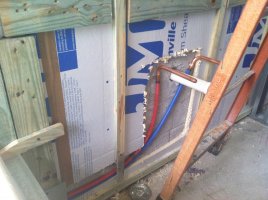-
Welcome to The Building Code Forum
Your premier resource for building code knowledge.
This forum remains free to the public thanks to the generous support of our Sawhorse Members and Corporate Sponsors. Their contributions help keep this community thriving and accessible.
Want enhanced access to expert discussions and exclusive features? Learn more about the benefits here.
Ready to upgrade? Log in and upgrade now.
You are using an out of date browser. It may not display this or other websites correctly.
You should upgrade or use an alternative browser.
You should upgrade or use an alternative browser.
How do you make this compliant? [see photo]
- Thread starter jar546
- Start date
I have noticed in your pictures of plumbing that the hot pipe is not insulated.
Should the cold be insulated for condensation?I have noticed in your pictures of plumbing that the hot pipe is not insulated.
jar546
CBO
I have noticed in your pictures of plumbing that the hot pipe is not insulated.
R403.5.3Hot water pipe insulation (Prescriptive).
Insulation for hot water pipe with a minimum thermal resistance (R-value) of R-3 shall be applied to the following:- 1.Piping 3/4 inch (19.1 mm) and larger in nominal diameter.
California doesn't have a section R403.5.3 but California has the same rule somewhere else.R403.5.3Hot water pipe insulation (Prescriptive).
Insulation for hot water pipe with a minimum thermal resistance (R-value) of R-3 shall be applied to the following:
- 1.Piping 3/4 inch (19.1 mm) and larger in nominal diameter.
steveray
SAWHORSE
Getting harder in 2021
N1103.5.2(R403.5.2)Hot water pipe insulation.
Insulation for service hot water piping with a thermal resistance, R-value, of not less than R-3 shall be applied to the following:- 1.Piping 3/4 inch (19 mm) and larger in nominal diameter located inside the conditioned space.
- 2.Piping serving more than one dwelling unit.
- 3.Piping located outside the conditioned space.
north star
MODERATOR
- Joined
- Oct 19, 2009
- Messages
- 4,596
$ = $
Rembo, what do the plans require ?.........If the sheet type
insulation is what is required, then have the plbg. contractor
remove their piping, have the full, "non-hacked up" sheet
of insulation applied to all areas of the wall, then have
the plbg. contractor to install their piping in a compliant,
"non-lazy manner", and then have another inspection
performed to verify the re-do.
$ = $
Rembo, what do the plans require ?.........If the sheet type
insulation is what is required, then have the plbg. contractor
remove their piping, have the full, "non-hacked up" sheet
of insulation applied to all areas of the wall, then have
the plbg. contractor to install their piping in a compliant,
"non-lazy manner", and then have another inspection
performed to verify the re-do.
$ = $
jar546
CBO
There is no room behind the drywall for insulation and the pipe.$ = $
Rembo, what do the plans require ?.........If the sheet type
insulation is what is required, then have the plbg. contractor
remove their piping, have the full, "non-hacked up" sheet
of insulation applied to all areas of the wall, then have
the plbg. contractor to install their piping in a compliant,
"non-lazy manner", and then have another inspection
performed to verify the re-do.
$ = $
north star
MODERATOR
- Joined
- Oct 19, 2009
- Messages
- 4,596
$ ~ $
The furring strips could be notched if done properly,
by someone who actually cares about the work \ project.
Then install nail guards over the notched areas.
Not the typical "wood butchering" plumbers.
$ ~ $
The furring strips could be notched if done properly,
by someone who actually cares about the work \ project.
Then install nail guards over the notched areas.
Not the typical "wood butchering" plumbers.
$ ~ $
Last edited:
my250r11
REGISTERED
Is the Insulation require? In a 1A would it need to be there or is the block it's self sufficient?
Exactly. That little bit of missing styrofoam can’t be a real problem.Is the Insulation require? In a 1A would it need to be there or is the block it's self sufficient?
jar546
CBO
It's not which is why we don't make a big deal about it. The main problem is that the block gets so hot, it heats the cold water.Exactly. That little bit of missing styrofoam can’t be a real problem.
I have encountered a heating issue with pipe in attics and on the exterior of the building. It can be significant. In your case the furred walls limit your choices. A thermal break might help. What do they do to mitigate the problem?It's not which is why we don't make a big deal about it. The main problem is that the block gets so hot, it heats the cold water.
If the CMU gets that hot why is there not a better insulation method?
Last edited:
mtlogcabin
SAWHORSE
mtlogcabin
SAWHORSE
When I lived down there my dad moved the electric water heater to the attic to save on electricity.
Hurricanes, alligators, pythons, bugs the size of dinner plates, more lightning strikes than anywhere else on Earth and now this…. The average Florida H/O insurance policy is $6000 for a reason.The water down there is already hot right out of the ground.
jar546
CBO
There is. It's called framing the inside wall and not just using PT furring strips. High-end homes definitely use metal framing on exterior walls but the other 98% of the homeowners get furring strips.If the CMU gets that hot why is there not a better insulation method?



